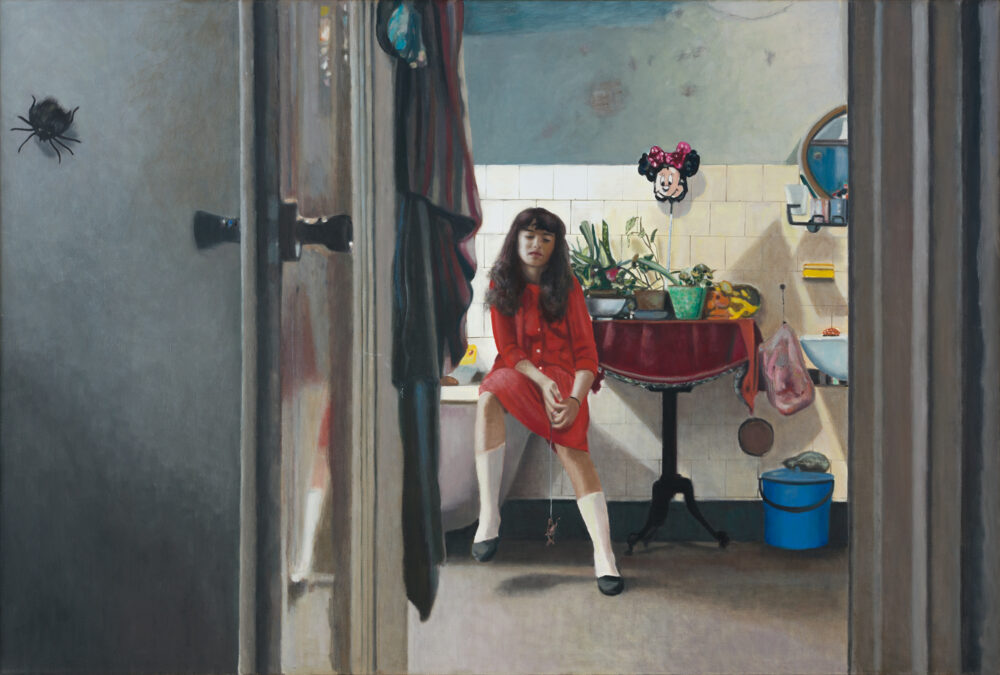
Łukasz Korolkiewicz
Krzysztof Zarębski
Dark Place Behind the Door
September 23 – November 30, 2016
The dark places behind the door are an unsettling, enigmatic space that is, at the same time, an element of our everyday lives. This is where our fears hide out, pushed beyond the confines of our consciousness. Unwanted, humiliating secrets feed off of darkness and silence. And while they make us tremble, they all pique our interest, titillate us, even.
The dark places behind the door are also places for two intriguing artists to meet: Łukasz Korolkiewicz (born 1948) and Krzysztof Zarębski (born 1939). Both make intruders out of audiences, dragging them into a perverse game that is aimed at showing us the truth about ourselves – our curious and prudish selves. In a subtle, albeit incisive way they reveal the deeply hidden layers of our humanity, stretched between innocent play and a loathsome perversion.
There are many shared themes between the two, which allow us to examine their works through similar aesthetic prisms. Such a confrontation reveals other meanings, which are already intensified by the act of comparison – both artists lead a sort of unconscious polemic, their works forming a double commentary on the other. They also exhibit a similar stance towards their role as artists, compelling one to consider them shameless tricksters who deceive others on a daily basis, arrogant commentators of their surrounding reality, who take great satisfaction in the bemusement they lead their audiences into.
For the past 40 years Łukasz Korolkiewicz has been painting large-scale paintings depicting the metaphysical prose of life. He places a protagonist-peeping tom into realistic home interiors, who is attempting to hide while also trying to get a glimpse of the viewer, only to reveal himself completely – sometimes even in the nude. This ambiguity is one of the basic traits of the trickster, who breaks cultural taboos. Korolkiewicz draws from traditional painting techniques, playing with stylistic and cultural conventions, often hiding his inspirations beneath the “cloak” of perversion. He stands in opposition, he alone, against everything, against the prevailing norm and its standards. Korolkiewicz’s exhibitionism is underlayed not as much by the need to expose himself, but to show his experience and let the viewer in to see a glimpse of himself within the artist – internally torn, greedy and inhibited all at once.
Łukasz Korolkiewicz is an artist who is painfully tradition and remarkably provocative. He is an imp whose childish game at times rises to the level of obscenity and tasteless, while remaining an art form full of erudition and irony.
Krzysztof Zarębski is considered a pioneer of performance art in his native Poland. He has lived in New York since 1981. The exhibition includes objects and sketches, along with documentation of his actions. His installations – creatively adopted attributes of the everyday, small and fragile, contrasting with the canvases of his fellow artist – nonetheless, quite a few looked as if they’d been pulled straight out of Korolkiewicz’s canvases. They may use entirely different media, but their fascination with the everyday, the passage of time and the body draw them together.
Zarębski’s peculiar objects, made of fake fingernails, spoons, vibrators, telephone speakers and magnetic tapes, lose their primary meaning to figure as an autonomous means of relaying knowledge about reality. This shift drives the analysis of his work through the aesthetics of camp: here are objects taken from our everyday lives pretending to be something they aren’t. A piece of wire, the elbow of a gramophone and a spoon take on the shape of an uncanny insect. A vibrator becomes a mobile mushroom. These experiments demonstrate how the orderly, bourgeois nature of our everyday lives still holds some potential for perversion. As Philip Core suggested, camp is “the lie that tells the truth”.
There is no limit to Zarębski’s sense of humour and sensibility, which allows him to perceive and evaluate the everyday in all of its aspects – even its most mundane, neglible parts.
His reputation as a “depraved handyman” only befits his trickster character, as he takes the crumbs that have been swept outdoors and creates an alternative reality out of them, drawing out the dark power of the prosaic.
The confrontation of Zarębski with Korolkiewicz demonstrates the divergence of ways we can get to universal truths about our very selves. All it takes is a crack of the door to light up the dark… or to curl up within it.
Mateusz Promiński